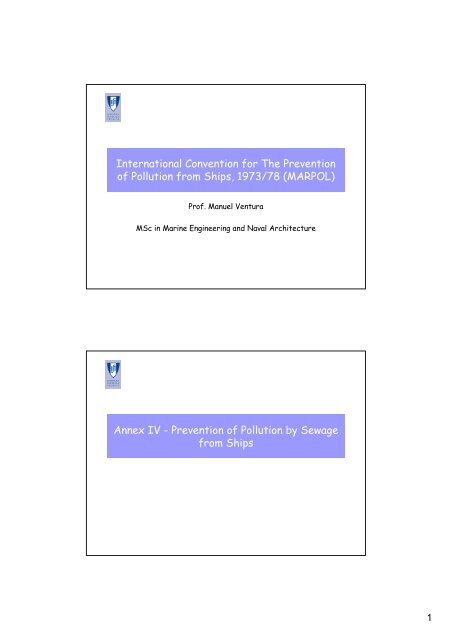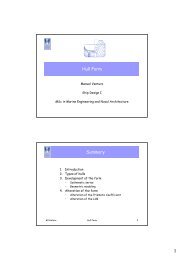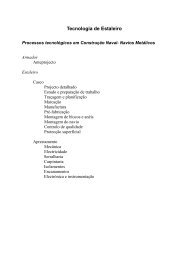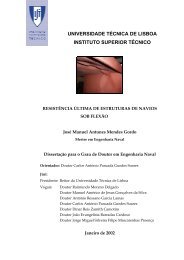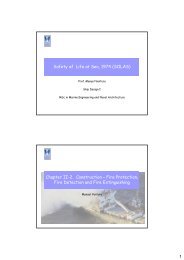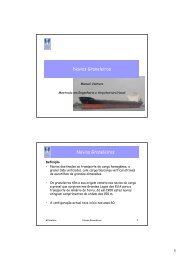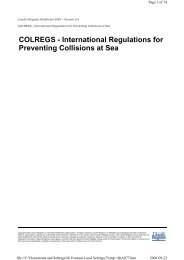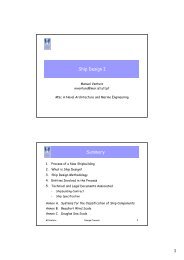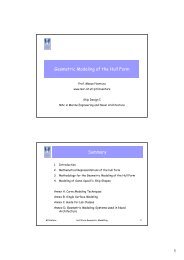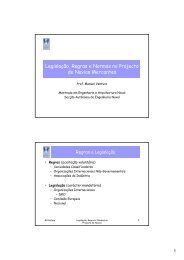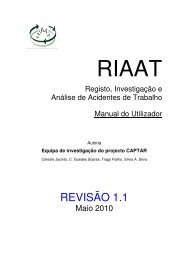Create successful ePaper yourself
Turn your PDF publications into a flip-book with our unique Google optimized e-Paper software.
International Convention for The Preventionof Pollution from Ships, 1973/78 (<strong>MARPOL</strong>)Prof. Manuel VenturaMSc in Marine Engineering and Naval ArchitectureAnnex IV - Prevention of Pollution by Sewagefrom Ships1
DefinitionsSewage means:1. drainage and other wastes from any form of toilets and urinals2. drainage from medical premises (dispensary, sick bay, etc.) viawash basins, wash tubs and scuppers located in such premises3. drainage from spaces containing living animals4. other waste waters when mixed with the drainages definedabove.Holding tank means a tank used for the collection and storage ofsewage.From the nearest land - means from the baseline from whichthe territorial sea of the territory in question is establishedin accordance with international lawM.Ventura <strong>MARPOL</strong> 3Prevention of Pollution by Sewage fromShipsApplication• Ships engaged in international voyages:– New ships of GT ≥ 400– New ships GT < 400 which are certified to carry more than 15personsM.Ventura <strong>MARPOL</strong> 42
Sewage SystemsEvery ship which shall be equipped with one of the followingsewage systems:• A sewage treatment plant• A sewage comminuting and disinfecting system fitted withfacilities for the temporary storage of sewage when the shipis less than 3 nautical miles from the nearest land• A holding tank of the capacity for the retention of all sewage,having regard to the operation of the ship, the number ofpersons on board and other relevant factors.M.Ventura <strong>MARPOL</strong> 5Chemical Sewage Treatment Plants (1)• Consists of a big storage tank whichcollects, treats and stores the sewage fordischarging it to the sea or to a shorereceiving facility.• The sewage is first collected in a tank andthe liquid content is reduced. This can bedone by flushing water from wash basinsand bathroom drains directly into the sea.• The liquid from any other sources istreated chemically to get rid of the colorand smell and then it is reused as flushingwater in toilets. The chemicals that areused assist in the process of breaking thesolid constituents and also in sterilization.M.Ventura <strong>MARPOL</strong> 63
Chemical Sewage Treatment Plants (2)• A mechanical instrument known as comminutor is used to helpbreaking down of the solid particles to smaller ones. The liquidsewage remains at the top and the solid particles settle down,which are then discharged to a sewage tank.• The liquid sewage is chemically treated and is used for toiletflushing purposes. The sewage from the sewage tank isdischarged to the shore collecting facilities.• It is important to supply adequate quantity of chemicaldosages to prevent odor and corrosion due to high level ofalkalinity.M.Ventura <strong>MARPOL</strong> 7Biological Sewage Treatment Plants (1)• Uses bacteria to facilitate theprocess of breaking down of solidconstituents.• It generates an oxygen richatmosphere that aerobic bacteriautilizes to multiply and disintegratethe sewage waste to convert it intosludge (aeration process).• The whole plant is divided into threecompartments:– Aeration compartment– Settling compartment– Chlorine treatment compartment.M.Ventura <strong>MARPOL</strong> 84
Biological Sewage Treatment Plants (2)• Sewage enters the sewage treatment plant first through theaeration compartment. Aerobic bacteria digests the sewage wasteand reduce it to small particles. A continuous supply of atmosphericoxygen is provided to increase the rate of digestion process.• The disintegrated solid waste is then transferred to the settlingcompartment where the solid constituents settle down under theeffect of gravity.• The liquid at the top is then passed to the chlorine treatmentcompartment. In this compartment the liquid water is treated withchlorine and other chemicals to kill any surviving bacteria. Once donethe water is then discharged into the sea.• The process of chlorination is facilitated with the help of chlorinetablets. The sludge that settles down in the settling compartment isremoved and stored in a storage tank to later discharge it to shorefacilities or decontrolled areas.M.Ventura <strong>MARPOL</strong> 9Discharge of Sewage• The discharge of sewage into the sea is prohibited, exceptwhen:1. The ship is discharging• comminuted and disinfected sewage at a distance > 3 nauticalmiles from the nearest land, or• sewage which is not comminuted or disinfected at a distance> 12 nautical miles from the nearest land,provided that in any case, the sewage shall not be dischargedinstantaneously but at a moderate rate when the ship is en routeand proceeding at V ≥ 4 knots2. The ship has in operation an approved sewage treatment plantand additionally, the effluent shall not produce visible floatingsolids nor cause discoloration of the surrounding water.M.Ventura <strong>MARPOL</strong> 105
Standard Discharge Connections• To enable pipes connections between the reception facilitiesand the ship, both lines shall be fitted with a standarddischarge connection in accordance with the following table:• For ships having a Depth ≤ 5 m, the inner diameter may be 38 mm• In alternative, ships in dedicated trades, i.e. passenger ferries,the ship’s discharge pipeline may be fitted with quick connectioncouplings.M.Ventura <strong>MARPOL</strong> 11Annex V - Prevention of Pollution by Garbagefrom Ships6
Definitions• Garbage - means all kinds of victual, domestic and operationalwaste excluding fresh fish and parts thereof, generatedduring the normal operation of the ship and liable to bedisposed of continuously or periodically• Special Area - means a sea area where for recognizedtechnical reasons in relation to its oceanographical andecological condition and to the particular character of itstraffic the adoption of special mandatory methods for theprevention of sea pollution by garbage is required.M.Ventura <strong>MARPOL</strong> 13Prevention of Pollution by Garbage fromShipsApplication• Unless expressly provided otherwise, the provisions of thisAnnex shall apply to all ships.M.Ventura <strong>MARPOL</strong> 147
Garbage Outside Special Areas (1)• The disposal into the sea of all plastics, including but notlimited to synthetic ropes, synthetic fishing nets, plasticgarbage bags and incinerator ashes from plastic productswhich may contain toxic or heavy metal residues, isprohibited.• The disposal into the sea of the following garbage shall bemade as far as practicable from the nearest land but isprohibited if the distance from the nearest land is less than:i. 25 nautical miles for dunnage, lining and packing materials whichwill floatii. 12 nautical miles for food wastes and all other garbage includingpaper products, rags, glass, metal, bottles, crockery and similarrefuseM.Ventura <strong>MARPOL</strong> 15Garbage Outside Special Areas (2)• The disposal into the sea of garbage specified insubparagraph (ii) may be permitted when:– it has passed through a comminuter or grinder and– Is made as far as practicable from the nearest land but in anycase is prohibited if the distance from the nearest land is < 3nautical miles.– Comminuted or ground garbage shall be capable of passingthrough a screen with openings
Garbage Processing Equipment (1)• Comminuter - is an oversizedgarbage disposal that reduces foodscraps to a finely chopped residual,which is rinsed out of the unit witha steady stream of water. Theeffluent is a slurry of water andfood bits.• Compactors - make garbage easierto store, to transfer to portreception facilities and to disposeof at sea when discharge limitationspermit.Delitek AS DT-200i WasteCompactorM.Ventura <strong>MARPOL</strong> 17Garbage Processing Equipment (2)• Shredder - ideal for most wastematerials such as various foodwaste including bones, paper andcardboard, tins and soda cans, PEsoda bottles, other PE materialsetc.Delitek AS DT-230 SRShredderM.Ventura <strong>MARPOL</strong> 189
Special Requirements for Disposal ofGarbage• The disposal of any materials regulated by this Annex isprohibited from:– fixed or floating platforms engaged in the exploration,exploitation and associated offshore processing of sea-bedmineral resources– all other ships when alongside or within 500 m of such platforms• The disposal into the sea of food wastes is permitted when:– They have been passed through a comminuter or grinder– They are located more than 12 nautical miles from landM.Ventura <strong>MARPOL</strong> 19Garbage Disposal in Special Areas• Disposal into the sea of the following is prohibited:i. all plastics, including but not limited to synthetic ropes,synthetic fishing nets, plastic garbage bags and incineratorashes from plastic products which may contain toxic or heavymetal residues; andii. all other garbage, including paper products, rags, glass, metal,bottles, crockery, dunnage, lining and packing materials• Disposal into the sea of food wastes shall be made as far aspracticable from land, at least > 12 nautical miles from thenearest land• Disposal into the Wider Caribbean Region of food wastescomminuted or grinded is acceptable at distances > 3 nauticalmiles from the nearest land.M.Ventura <strong>MARPOL</strong> 2010
Special AreasFor the purpose of this Annex, the special areas are:• the Mediterranean Sea area• the Baltic Sea area• the Black Sea area• the Red Sea area• the “Gulfs area"• the North Sea area• the Antarctic area• the Wider Caribbean Region, including the Gulf of Mexico andthe Caribbean SeaM.Ventura <strong>MARPOL</strong> 21Summary of Garbage Disposal RegulationsM.Ventura <strong>MARPOL</strong> 2211
Summary of Garbage Disposal RegulationsNOTES:M.Ventura <strong>MARPOL</strong> 23M.Ventura <strong>MARPOL</strong> 2412
Compaction Options on BoardM.Ventura <strong>MARPOL</strong> 25Incineration Options (1)M.Ventura <strong>MARPOL</strong> 2613
Incineration Options (2)M.Ventura <strong>MARPOL</strong> 27Annex VI - Prevention of AtmosphericPollution by Ships14
DefinitionsEmission - means any release of substances, subject to control by thisAnnex from ships into the atmosphere or sea.Sludge oil - means sludge from the fuel or lubricating oil separators,waste lubricating oil from main or auxiliary machinery, or waste oilfrom bilge water separators, oil filtering equipment or drip trays.Ozone Depleting Substances – substances that may be found on boardship include, but are not limited to:– Halon 1211 Bromochlorodifluoromethane– Halon 1301 Bromotrifluoromethane– Halon 2402 1,2-Dibromo-1,1,2,2-tetrafluoroethane (Halon 114B2)– CFC-11 Trichlorofluoromethane– CFC-12 Dichlorodifluoromethane– CFC-113 1.1.2-Trichloro-1,2,2-trifluoroethane– CFC-114 1.2-Dichloro-1,1,2,2-tetrafluoroethane– CFC-115 ChloropentafluoroethaneM.Ventura <strong>MARPOL</strong> 29Prevention of Atmospheric Pollution byShipsApplication• The provisions of this Annex shall apply to all ships.M.Ventura <strong>MARPOL</strong> 3015
Prevention of Atmospheric Pollution byShipsRegulates• Substances that affect the ozone• Emissions of Nitrogen Oxides (NOx) from Diesel engines• Content of Sulphur Oxides (SOx) in the Fuel Oils• Emission of Volatile Organic Compounds from cargo tanks oftanker ships• Incinerators• Reception Facilities• Quality of the Fuel Oils• Issuing of the CertificateM.Ventura <strong>MARPOL</strong> 31Shipboard Incineration• Shipboard incineration shall be allowed only in a shipboardincinerator• Incineration of the following substances shall be prohibited:– Annex I, II and III cargo residues of this convention and relatedcontaminated packing materials– polychlorinated biphenyls (PCBs)– garbage, containing more than traces of heavy metals– refined petroleum products containing halogen compounds• Incineration of sewage sludge and sludge oil generated duringthe normal operation of a ship is accepted in the main orauxiliary boilers, but not inside ports, harbours and estuaries.• Incineration of polyvinyl chlorides (PVCs) shall be prohibitedM.Ventura <strong>MARPOL</strong> 3216
Annex VI Revision• The revised <strong>MARPOL</strong> Annex VI (Regulations for thePrevention of Air Pollution from Ships) and the revised NOxTechnical Code 2008 were adopted by IMO’s MarineEnvironment Protection Committee in October 2008• Entry into force date of 1 July 2010.• The reviewed documents includes:– The revised <strong>MARPOL</strong> Annex VI (Regulations for the Preventionof Air Pollution from Ships), including emission limits andoperational requirements– The NOx Technical Code 2008, is made mandatory under<strong>MARPOL</strong> Annex VI for all marine diesel engines with a poweroutput of 130 kW or more, and provides the requirements for thetesting, survey and certification of marine diesel engines– Interim guidelines for application of the NOx Technical Code2008– Standard specifications for shipboard incinerators.M.Ventura <strong>MARPOL</strong> 33International Convention for the Control andManagement of Ships’ Ballast Water andSediments (BWM), 2004Prof. Manuel Ventura17
Protection of the Marine Eco-Systems• It is estimated that about 10 billion tons of ballast water aremoved annually by the merchant ships, 100 millions of tons ofsediments and microscopical marine species are transferredto environments in relation to which they are foreign andoften noxious or destructives• The ballast water is responsible, for example, for theintroduction of the toxic dinoflagelaciae, a type of algae• These algae can survive during year inside the ballast tanks• Once discharged into another environment they are able topoison some marine species and even humansM.Ventura <strong>MARPOL</strong> 35Technologies Applied• Reduction of the entry of organisms on board (filters)• Retention of the ballast water on board• Treatment systems by facilities on shore• Renewal of the ballast water in the sea• Treatment of the ballast water on board, before dischargingM.Ventura <strong>MARPOL</strong> 3618
Retention of the Ballast Water on Board• Not compatible with the normal operations ofloading/unloading• Can be not feasible due to safety reasons related with thetrim and the stability of the ship• Generally it is not an option for the ocean going ships• Requires reception facilities on shoreM.Ventura <strong>MARPOL</strong> 37Treatment Systems by Facilities on Shore• Requires the ship to have a ballast system with capacity topump to shore• The salt content of the water and the high flow rate requiredprevents the usage of most port systemsM.Ventura <strong>MARPOL</strong> 3819
Renewal of the Ballast WaterAdvantages• Most used• Does not require adaptations of the ship• It is not very costlyDisadvantages• Demands the ballast to be pumped 3 times• Hull subject to a stress increase• Stability problems• Higher FO consumption• More emissionsM.Ventura <strong>MARPOL</strong> 39Ballast Water Treatment Systems• Separation/filtering - to minimize the quantity of sedimentscoming into the ballast tanks• Ultra-Violet RadiationM.Ventura <strong>MARPOL</strong> 4020
Ballast Water Management• Entries into force 12 month after the ratification by 30states, representing 35% of the tonnage of the worldmerchant fleet• Reception Facilities– The ports and terminals where ballast tank cleaning or repairsoccur shall have adequate reception facilities for the sediments• Research and Monitoring– The scientific and technical research on ballast watermanagement shall be promoted– The results from the ballast water management shall bemonitored• Inspection and CertificatesM.Ventura <strong>MARPOL</strong> 41Water Ballast Management Plan• Ships shall implement and have on board a Water BallastManagement Plan, approved by the Administration• Ships shall have a Ballast Water Register Book, where it isrecorded:– When the ship is ballasted– When the ballast is renewed or treated– When ballast is discharged into the sea– When ballast is discharged into reception installations, on shore– Accidental ballast dischargesM.Ventura <strong>MARPOL</strong> 4221


